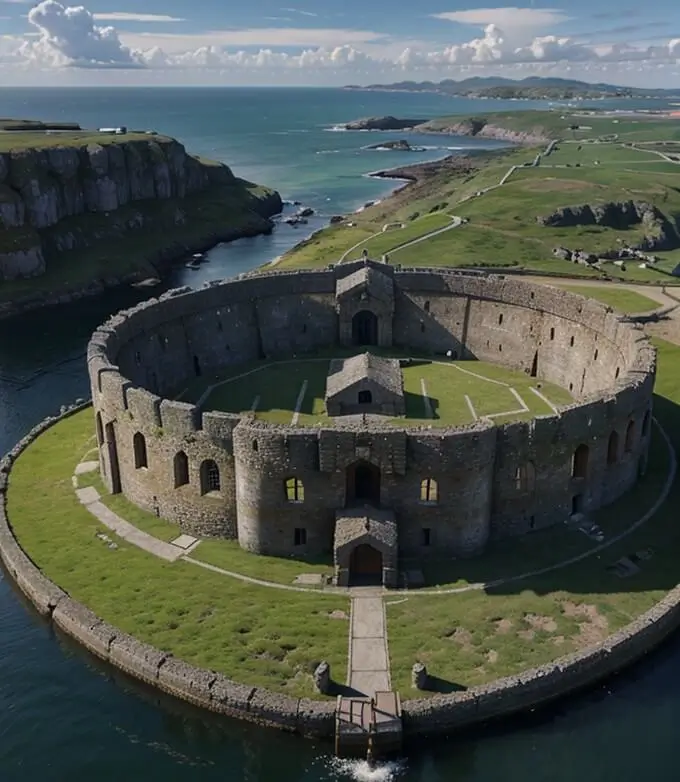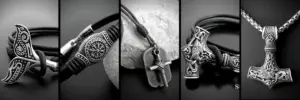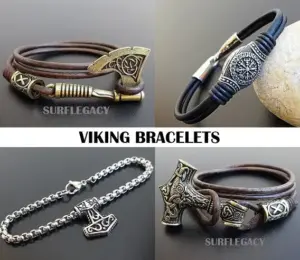The intriguing tales of Jomsborg, a semi-legendary Viking stronghold, have sparked imaginations for centuries. This fortress, featured prominently in medieval sagas and chronicles, stands as the bastion of the formidable Jomsviking warriors, adding a touch of mystique to its storied history.
While modern historians debate whether this fortress existed, where it was located, and the veracity of tales about it, there are tantalizing clues that point to Jomsborg being a real place that played a role in Viking Age history and legend.
Early Medieval Sources on Jomsborg
One of the earliest surviving sources mentioning Jomsborg is the “Gesta Hammaburgensis ecclesiae pontificum” (Deeds of the Bishops of Hamburg) written, by a German medieval chronicler Adam of Bremen, in the 11th century. In Book 4 of this text, which provides a geographical overview of Northern Europe, Adam describes a Viking fortress somewhere in the Baltic Sea that was home to a band of skilled warriors adhering to their own code.

Adam of Bremen
While the accuracy of Adam’s account is debated by modern historians, it provides contemporary evidence that a place fitting the description of Jomsborg was known as early as the mid-11th century. The exact location is not specified, but Adam notes it was in “Wendland”, corresponding to the coastal region of Pomerania along the Baltic in modern day Poland and Germany.
Over the next few centuries, tales of Jomsborg and its legendary inhabitants, the Jomsvikings, grew. Two 13th century Icelandic sagas, the “Knýtlinga saga” and “Fagrskinna”, claim Jomsborg was built by the Danish King Harold “Bluetooth” Gormsson in the 960s AD. They depict it as an impenetrable wooden fortress enclosed by ramparts and towers, with a great hall, rowdy banquets, and ferocious warriors.
The later “Jómsvíkinga saga”, from the 13th century, focuses on the adventures of the Jomsvikings themselves, portraying them as an elite band of Viking mercenaries adhering to a strict code who inhabited and protected the fortress. It describes initiation rituals requiring new recruits to prove their bravery, as well as laws dictating honorable behavior in combat.
Archeological Evidence
While details of the sagas may be fanciful, recent archaeological evidence lends credence to the idea that an important Viking site matching the description of Jomsborg existed around the late 10th century in the Pomerania region.
In the 1940s, amateur archaeologist Stefan Sielski discovered the ruins of a large wooden structure with an underground chamber containing 10th century artifacts on a hill near the Polish village of Wiejkowo. Though the significance of the finds was not recognized at the time, in 2014 Sielski’s great-granddaughter Maja brought one of the artifacts, a small gilded disc, to show her teacher.
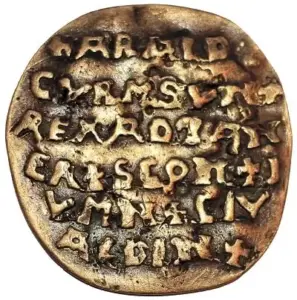
Credit image
This disc, now known as the Curmsun Disc, contains a Latin inscription translating to “Harald Gormsson, King of the Danes, Scania, Jomsborg, [and] Aldinburg.” This clearly identifies the Danish King Bluetooth as associated with Jomsborg in the 10th century. The location of the disc’s discovery in Wiejkowo, at one proposed site for Jomsborg, cements the association.
In the neighboring town of Wolin, archaeologists recently uncovered remnants of a large 10th century fortification on an island in the Oder River estuary. Wooden structural remains, ramparts, and artifacts closely match the descriptions of Jomsborg from medieval sources.

The leader of the excavation, Dr. Wojciech Filipowiak, stated “”The debate over Jomsborg’s location — or if it really existed — has been a very long discussion. Hopefully, I can help end it.”
Though Filipowiak stopped short of definitively declaring the site to be Jomsborg, these discoveries provide tantalizing evidence that a Viking fortress resembling and potentially identified with Jomsborg existed around Wolin in the late 10th century.
Jomsborg’s Founding
Assuming Jomsborg was a real place, who founded it and why? The medieval sources offer contradicting origin stories.
The aforementioned Icelandic sagas credit Danish King Harold Bluetooth with building Jomsborg sometime in the 960s AD, soon after he converted the Danes to Christianity and consolidated his power.
Some scholars speculate Bluetooth constructed Jomsborg as a means of exerting his authority in the Baltic region and diverting troublesome pagan warriors away from Denmark, housing them in a fortified camp overseas.
However, the later Danish chronicle “Gesta Danorum”, by Saxo Grammaticus, claims a Danish nobleman named Palnatoke founded Jomsborg at the start of the 10th century as a stronghold for leading pagan warriors who refused to convert to Christianity under Bluetooth’s rule in Denmark. In this version, Palnatoke essentially established a rebel base of operations to resist Bluetooth’s Christianization policies.
Ultimately, the true origins of Jomsborg are unclear. It may have been founded independently by Palnatoke earlier in the 10th century before being captured and reinforced by Bluetooth in the 960s. The discrepancy highlights the blending of history and myth in medieval sources about Jomsborg.
The Jomsvikings
Inhabitants of Jomsborg were known as the Jomsvikings. According to legends, they adhered to a strict code requiring unconditional bravery in battle, unwavering loyalty to their leaders, and maintaining secrecy about their identities. Jomsborg essentially operated as their elite training camp and base of operations.
The identities of early Jomsviking leaders are semi-legendary, though the Danish nobleman Sigvaldi Strut-Haraldsson is frequently cited as an early chieftain of the order in the late 10th century. Under his leadership, Jomsvikings were involved in major power struggles and battles of the era.
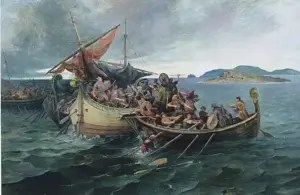
The Jomsvikings in a naval battle by Nils Bergslien
In the 980s, one saga claims Sigvaldi and a force of Jomsvikings assisted Swedish ruler Styrbjörn the Strong in an attempt to reclaim his father’s kingdom from Eric the Victorious, only to meet defeat in the Battle of Fýrisvellir when Eric’s reinforcements turned the tide against them. This was an early instance of their participation in larger Nordic power conflicts.
The Battle of Svolder
The most famous depiction of the Jomsvikings is their role in the legendary naval Battle of Svolder in 999 or 1000 AD. One saga account describes how Sigvaldi and the Jomsvikings were hired by Danish King Sweyn Forkbeard to eliminate Norwegian ruler Earl Haakon Sigurdsson, who ruled Norway nominally on behalf of Sweyn’s father King Harald Bluetooth.
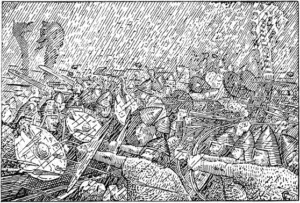
Olav Tryggvasons saga – Jomsvikings fighting in a hail storm
Yet they failed to defeat Haakon, who hid in a fjord and eventually routed them in the Battle of Hjörungavágr. This marked a low point for the elite Jomsviking order. However, Haakon died of sickness the next year, allowing Sweyn to take direct control of Norway and avenge the defeat.
A decade later, Sweyn conspired with Sigvaldi to lure King Olaf Tryggvasson of Norway, who had conquered Norway from him, into a trap. Sigvaldi and the Jomsvikings sailed out to meet Olaf’s fleet, pretending to offer their services, then ambushed them at the island of Svolder.
Surrounded by Sweyn’s allies, Olaf’s longships were ingeniously lashed together to form a floating circle fortress. Though outnumbered, Olaf and his men fiercely defended their ships even as the Jomsvikings repeatedly boarded them.
The battle ended when Einar Tambarskjelve finally shot an arrow that killed Olaf, allowing the Jomsvikings to overrun the remainder of his forces. This legendary clash demonstrated the later peak martial prowess of the Jomsvikings before their decline.
Destruction by Magnus the Good
According to saga accounts, Jomsborg and the Jomsvikings met their ultimate demise in 1043 AD at the order of King Magnus I of Norway, known as “the Good.” After a Jomsviking uprising against Magnus’ father led to their banishment, he became determined to neutralize the threat of their fortress and elite warriors.
Sailing to Jomsborg with a fleet, Magnus besieged the fortress, ultimately overwhelming its defenses through use of siege engines and catapults. After breaking through the fortifications, Magnus razed Jomsborg to the ground, killing many inhabitants.
This attack ended the legendary stronghold’s role as a strategic base for the Jomsvikings. The defeated Jomsviking survivors were reportedly executed at a spot thereafter known as the “Jomsvikings’ Meadow”, marking the end of their order’s golden era as recounted in sagas.
Legacy
While the destruction of Jomsborg cannot be confirmed, excavations at Wolin showing signs of violent destruction in the early 11th century lend credence the sagas’ account of its downfall under Magnus.
Though details are blurred by myth-making, Jomsborg’s memory lived on through the middle ages, inspiring awe as a near-mythical Viking fortress populated by some of the fiercest warriors of the era.
Recent archaeological evidence and artifacts like the Curmsun Disc suggest there was a real Viking fortress at the heart of the legends. While debate continues, the mystique of Jomsborg endures as a symbol of the brave, adventurous Viking spirit.
The story of this stronghold and its legendary Jomsviking defenders represents the climax of the Viking Age – where history, myth, and imagination collide.
Key Takeaways
- Jomsborg was a semi-legendary Viking fortress mentioned in medieval sagas and chronicles. Its exact location is unknown but theories point to the southeastern Baltic coast.
- Recent archaeological evidence like the Curmsun Disc and 10th century fort ruins at Wolin lend credence to Jomsborg’s existence, though details remain shrouded in mystery.
- The fortress was likely founded in the 10th century, either by King Harold Bluetooth or earlier by rebel leader Palnatoke, according to conflicting medieval sources.
- Jomsborg was inhabited by an elite order called the Jomsvikings who followed a strict warrior code, according to legends.
- The Jomsvikings participated in major Viking battles and power struggles in the late 10th/early 11th centuries.
- Sagas claim Norwegian King Magnus the Good attacked and destroyed Jomsborg around 1043 AD after a Jomsviking revolt.
- While its exact fate is unclear, Jomsborg remains an enduring symbol of the adventurous Viking spirit. Ongoing archaeological discoveries may help unravel its mysteries.
Jomsborg Faqs
Where was Jomsborg located?
The exact location is still unknown, but theories point to the southeastern Baltic coast in modern-day Poland and Germany, potentially on Wolin Island near the mouth of the Oder River. Recent archaeological evidence in the area lends credence to this regional location.
Did Jomsborg really exist or is it just a myth?
While some details are mythologized, recent archaeological discoveries like the Curmsun Disc and remnants of a 10th century fort at Wolin suggest there was a real Viking fortress at the core of the Jomsborg legends. But its precise attributes are still shrouded in mystery.
When was Jomsborg founded and by whom?
Theories conflict – some medieval sources claim King Harold Bluetooth built it in the 960s AD, while others credit rebel leader Palnatoke with founding it earlier in the 10th century. Ultimately, its origins are unclear.
What happened to Jomsborg and the Jomsvikings?
According to sagas, the Norwegian King Magnus the Good attacked and destroyed Jomsborg in 1043 AD after a Jomsviking revolt, executing many inhabitants. Archaeological evidence of destruction at Wolin around this time seems to corroborate this account.
Did the Jomsvikings really have special powers?
Tales of their superhuman abilities are doubtless exaggerated. However, sagas do indicate they followed a strict warrior code and rigorous training, which may have contributed to their elite reputation as fighters.
Could Jomsborg be rediscovered today?
Ongoing excavations at Wolin may uncover conclusive proof if it is indeed the site of fabled Jomsborg. But finding unambiguous evidence after 1000+ years is a challenge. Parts may remain lost to time.
Conclusion
The mysteries surrounding Jomsborg have endured for centuries, conjuring images of a formidable Viking fortress inhabited by some of the most skilled warriors of the medieval Nordic world.
While many specifics remain elusive, the recent convergence of physical evidence from sites like Wolin with clues found in medieval literary traditions bring us closer than ever to unmasking the realities behind the legends of Jomsborg.
As archaeologists continue to excavate the windswept Baltic coast, the ruins of this fabled stronghold may finally emerge from beneath the sands of time. But even if Jomsborg’s exact location and history evade us, its powerful mystique will live on – the epitome of Vikings’ adventurous, free-wheeling spirit reflected across the centuries.
For now, the search continues, with tantalizing new discoveries perhaps waiting just around the bend to unravel the fortress’ enduring secrets.
Shop Viking Jewelry
Are passionate about Vikings or Norse Mythology?
Finding the ideal piece of Viking Jewelry can be challenging and time-consuming, especially if you lack inspiration or don’t know where to look.
Surflegacy, has you covered. We have a wide range of Handmade Jewelry in various styles, shapes, colors, and materials, to accentuate your Viking spirit and look. Do not hesitate to visit our selection HERE

